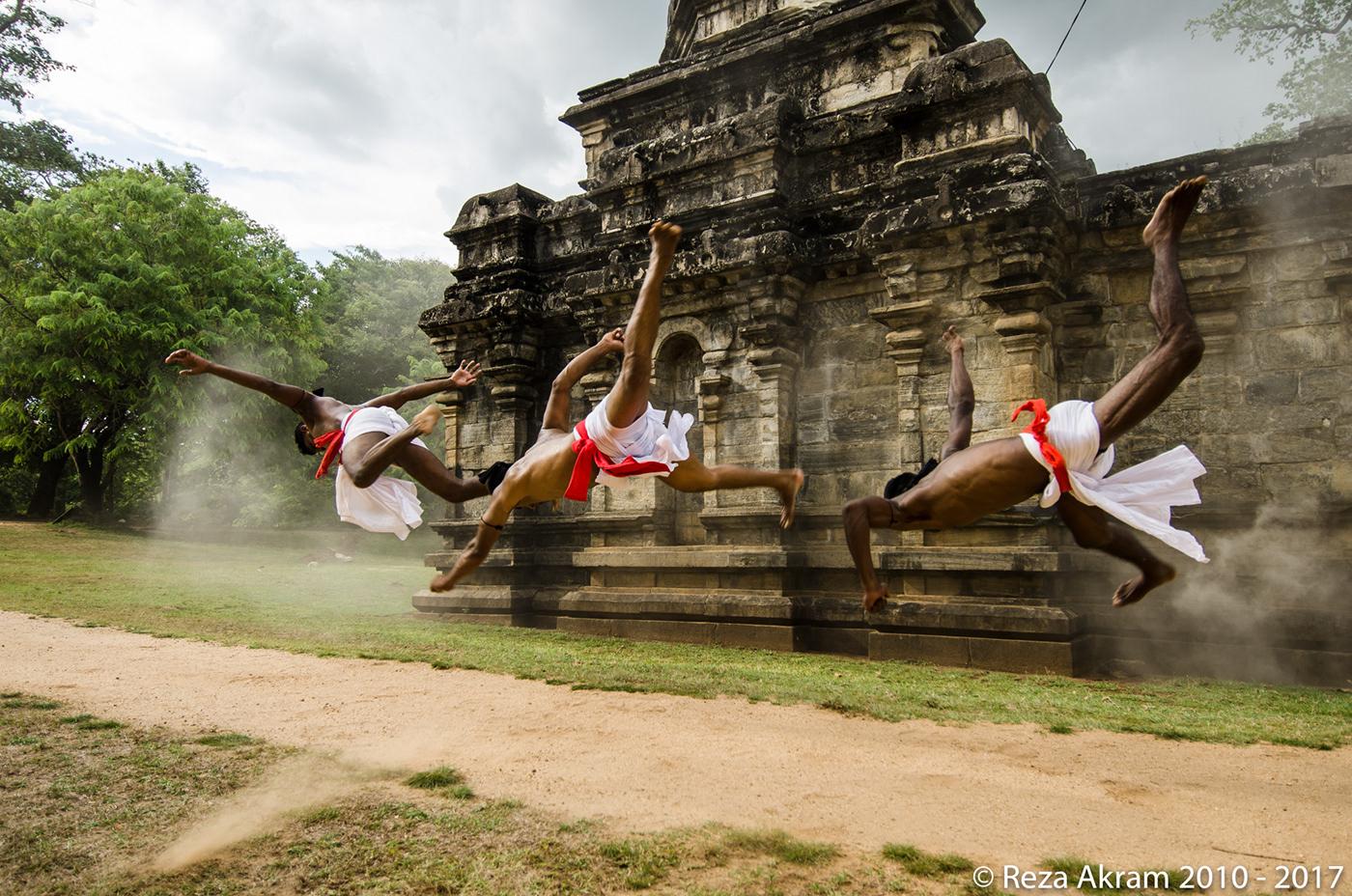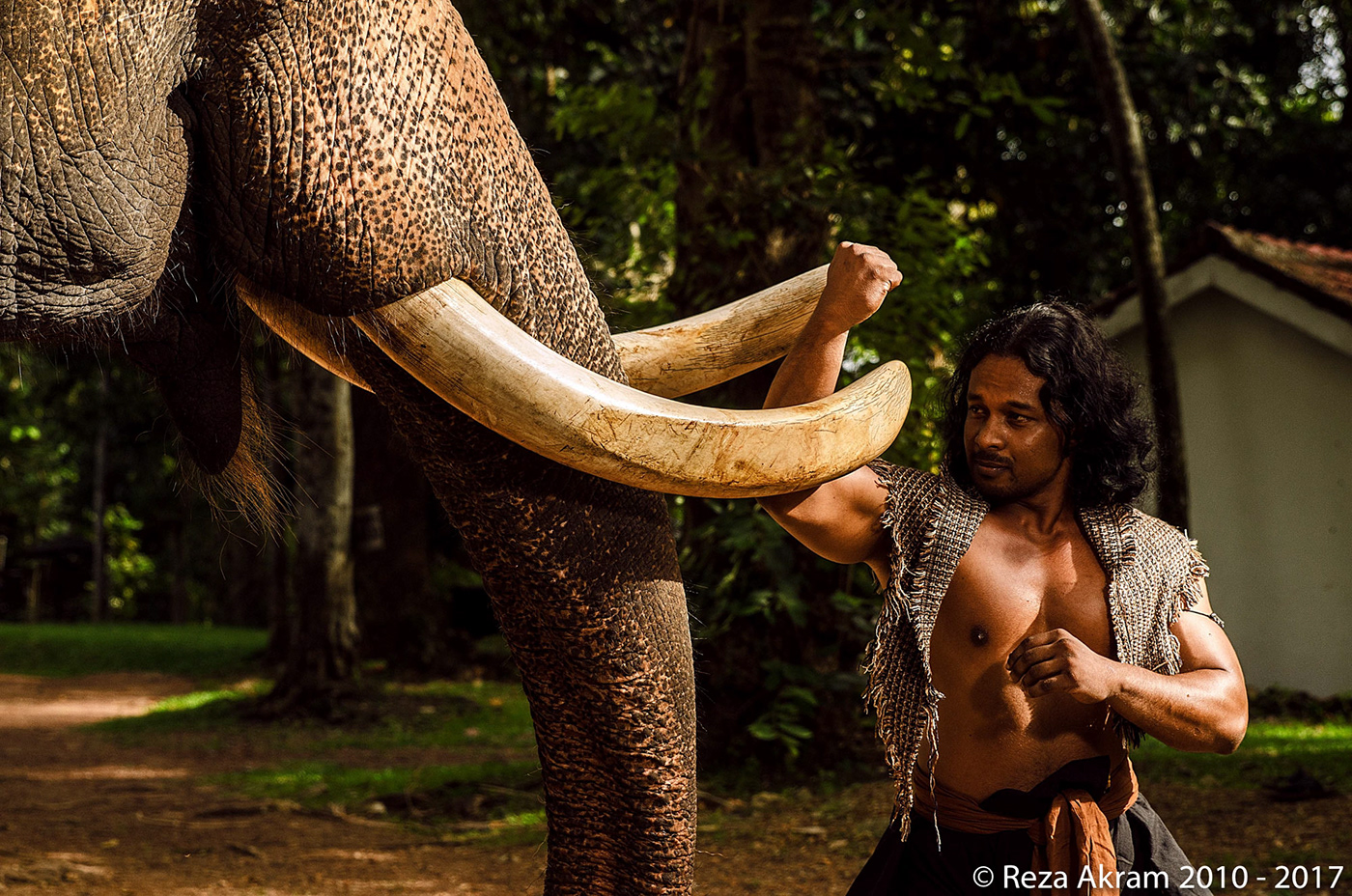Possibly the oldest and most secret of martial arts in the world has finally revealed itself. Angampora, Sri Lanka's ancient martial art, is a deadly and mysterious discipline that practitioners believe originated in a legendary era more than 30,000 years ago. Angampora is a science of combat that combines unarmed and armed combat, deadly pressure-point attacks, meditation, and esoteric practices that have their roots in a time far before history can recall. The art was outlawed and systematically driven to decline after 1818 (exactly 200 years ago) by the British, and it was believed by many to be extinct, but it was not. It was kept alive in secret by families of practitioners, and a vestige of an ancient time has survived to this day. This collection of pictures gives a rare glimpse into the fascinating art of Angampora in a way never seen by the world.They are taken from Angampora: A Nation's Legacy in Pictures, a coffee-table book written by Deshamanya Ajantha Mahanthaarachchi, photographed by Reza Akram, and published by Oceans and Continents Sri Lanka. The book is the first of its kind in the world to compile a comprehensive visual record of combat techniques, secret rituals, and ancient artifacts of this ancient art to narrate a story about a hidden cultural heritage never seen or heard by the world before. Angampora: A Nation's Legacy in Pictures is now available for worldwide purchase through Amazon.com and in Sri Lanka through Kapruka.com! All images copyrights © Reza Akram 2010 - 2017.
For more information about the project, contact Oceans and Continents.
Book is available on Amazon - Link: http://a.co/d08uc8x

Angampora was an art of war that was used by ancient Sri Lankan Kingdoms to defend the nation from external threats. As such, Illangam, or the art of weapon combat in Angampora, has been a core component of the discipline since ages past. © Reza Akram 2010 - 2017

Locks and grips, (Sinhala: "gata-puuttu") with or without weapons, is a key part of Angampora combat. There are more than 60 different locks and grips that have been transmitted through the centuries to this day. © Reza Akram 2010 - 2017

Traditional combat takes place amidst the rhythm of ancient Sinhala war drums. © Reza Akram 2010 - 2017

Figure of armed Angampora fighter on an ivory comb held at the National Museum in Colombo. Angampora motifs were popular among traditional craftsmen and artisans of ancient times. As such, motifs with Angampora fighters can be seen in a range of ancient Sri Lankan artifacts. © Reza Akram 2010 - 2017

An ancient painted cloth, known as a "Somana" measuring 5 meters across artistically represent the preparation of armies for war. This invaluable painted cloth lies in a state of neglect in the National Museum in Ratnapura. © Reza Akram 2010 - 2017

The pen is mightier than the sword. The British decree (pictured) to ban Angampora came in the wake of the Uva-Wellassa freedom fight in 1818. The freedom fight was headed by noblemen such as Monaravila Keppetipola and other noblemen who were distinguished Angampora warriors. The order by Governor Robert Brownrigg was executed by John D'Oyly, effectively cracking down on the Sudaliya and Maruwaliya Angam lineages who were responsible for training the King's armies. This decree signalled the rapid decline of Angampora over the following decades. This document is presently held at the National Archives in Kew, London.

After the banning, Angampora movements and techniques assimilated into other traditional Sri Lankan arts such as dancing and drumming. Pictured is a drummer performing a backflip; a movement influenced by Angampora. © Reza Akram 2010 - 2017

Chokehold using a sash (Sinhala: Saluwa), a manouver known as the "salu getaya". © Reza Akram 2010 - 2017

Fingers are an important weapon for Angampora fighters. Fighters strengthen their fingers using traditional exercises in order to deliver lethal attacks to vital points in the body that could kill, paralyse, or maim instantly. Training in the secret science of pressure points in Angampora is given only to the most advanced students. © Reza Akram 2010 - 2017

© Reza Akram 2010 - 2017

The initiation into the Angampora traditionally begins very early in life. The minimum age for a pupil, male or female, is 6 years. First the prospective child’s horoscope is carefully examined by the chief Buddhist monk of the village and the Angampora teacher, and upon its favorability, an auspicious time is fixed, in line with the dictates of astrology. Thereafter customary rituals are met, traditional vows taken, and, only then, the first drill lesson is taught. This is the practice now and that’s the way it was, a long, long time ago. © Reza Akram 2010 - 2017

Since the distant past, women too practiced Angam in the same capacity as men. Female warriors such as Ratnapäli, Mahäpäli, Kaviläshapäli, and Navarathna Meniké, have been chronicled in many records throughout different eras of Sri Lanka's documented history. © Reza Akram 2010 - 2017

Airbourne
Jumping is an important element of Angampora combat. © Reza Akram 2010 - 2017

A traditional drill known as "dandukanda puuttuwa" that enhances core strength and coordination. © Reza Akram 2010 - 2017

© Reza Akram 2010 - 2017

© Reza Akram 2010 - 2017

Traditional exercises to strengthen arms by using an elephant's tusks. Unfortunately, the art of "Ath-Adi" or elephant foot drill in Angampora is nearly completely extinct. © Reza Akram 2010 - 2017

In developing the extreme physical stamina that is needed of a Angam warrior, sparing with Gaur, tamed buffaloes and wild water buffaloes was common practice. Domesticated buffaloes were an integral part of the agricultural society of ancient Sri Lanka. Buffaloes were used to plow the paddy fields back in the day, and are still used for the same purpose even today. © Reza Akram 2010 - 2017

© Reza Akram 2010 - 2017

© Reza Akram 2010 - 2017

Ethunu Kaduwa.
A flexible sword with multiple blades. This weapon is one of the deadliest weapons in the Illangam armoury. Each of these double edged blades is 6 feet in length and was used by elite fighters to annihilate entire troops of enemies. A single hilt can hold up to 24 blades. © Reza Akram 2010 - 2017

Combat with flambeaux (Sinhala: "gini pandam") was a highly advanced combat skill that was used in the battlefield since ancient times. This combat technique assimilated into traditional temple ceremonies in later times. © Reza Akram 2010 - 2017

"Illangakkaruwan" were specially skilled bands of fighters that had their heyday during the Sitäwaka period (16th Century A.D.). They were known to operate in small bands and their key strategy was stealth. When they strike upon an unsuspecting stronghold, their delivery is often lethal. These fighters could be compared to the elite special forces of today's armies. © Reza Akram 2010 - 2017

The stalk of the lotus leaf is used as a training instrument to practice the precise weight that a pressure point attack should be delivered. These teachings are accessible only to the most senior disciples. © Reza Akram 2010 - 2017

A fighter holding a traditional weapon known as "an-kirinnya", a handheld melee weapon made of deer antlers. © Reza Akram 2010 - 2017

A traditional blessing ceremony prior to the commencement of a secret annual combat ritual of the Korathota Angam lineage. © Reza Akram 2010 - 2017

Invoking mystical powers onto a combatant.
Angampora's greatest secrets are the esoteric practices known as "Mäyä Angam" that have existed since the distant origins of the art. Using ancient spiritual practices, Angam fighters channel light and dark energies and manifest them through spells, incantations, charms, and a range of techniques that are only divulged to the most accomplished practitioners due to the serious effects of such practices. © Reza Akram 2010 - 2017

Leopard canine or sometimes the canine of the smaller species, the Fishing Cat, is chanted on; It is customary of most Angam Combatants to wear such a charmed denture around their necks, thereby ensuring the nullification of malevolent effects of black magic practiced in Mayä Angam. © Reza Akram 2010 - 2017

Káthi Hangalé body armor - This is a special vestment made with several layers of specially treated cloth to withstand whacks and piercing lunges of the sharpest sword; Over it is worn a water seasoned leather jacket that can stop a jabbing arrow. © Reza Akram 2010 - 2017

Palingu Dhèhena: Meditation practiced to fortify the mind and the sight. Crystals are used in this exercise to channel focus of the eyes. The objective of the exercise is to improve peripheral vision and to be able to move each eye independently. © Reza Akram 2010 - 2017

Meditative drills practiced in Angampora is known as "dhèhen", meaning trance. Through the practice of such "dhèhen",one is able to inculcate an inner strength as well as to acquire mystic powers on to oneself. © Reza Akram 2010 - 2017

